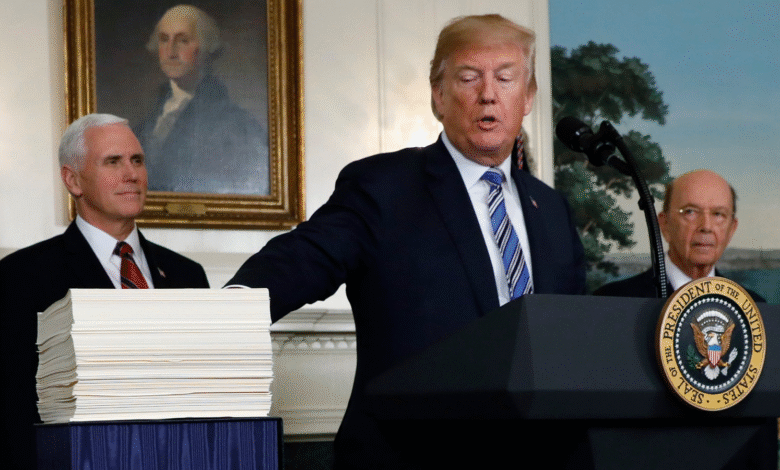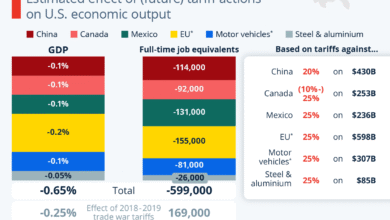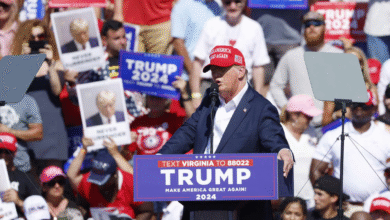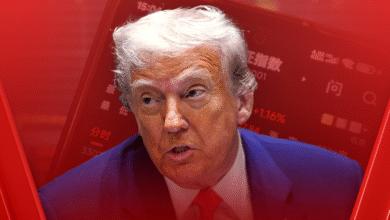Trump’s Spending Bill Advances in Key Senate Vote

Trump’s spending bill, dubbed the “big, beautiful bill,” has successfully passed a crucial procedural vote in the Senate, marking a significant step toward its potential enactment. This sweeping Republican spending package is poised for extensive debate as the Senate prepares for a marathon discussion on its intricate 940 pages. The vote, which concluded late Saturday night, saw 51 Republicans supporting the measure while 49 Democrats opposed it, indicating the divided nature of the current political landscape. With pressing deadlines looming, Senate Majority Leader John Thune is determined to expedite the process and deliver the Trump budget proposal to the president by July 4. However, lingering concerns about its passage through the House remain, particularly given diverging opinions among lawmakers on its key components.
The recent advancement of President Trump’s financial initiative highlights a pivotal moment in the ongoing legislative process. Often referred to as the Republican spending package, this extensive proposal encapsulates the administration’s fiscal plans and priorities. As debates heat up in the Senate, the focus shifts towards its complex provisions and the political maneuvering essential for its passage. The upcoming Senate procedural vote will determine whether this significant budget measure can withstand scrutiny and rally bipartisan support. In light of the coming July 4 deadline, the pressure mounts on lawmakers to align their interests with the overarching goals put forth by the Trump administration.
Understanding Trump’s Big Beautiful Bill
Trump’s ‘big, beautiful bill’ represents an ambitious spending package aimed at reshaping domestic policy and fulfilling key campaign promises. As the bill progresses through the Senate, it heightens the focus on numerous socio-economic reforms touted by President Trump. This spending package is significant not merely for its scale but for its potential impact on various sectors, including healthcare, infrastructure, and defense. As it stands, understanding the intricacies of the bill is crucial for analysts and constituents alike since it could determine funding allocations across the nation.
As the debate unfolds, key elements of the Trump Senate bill will likely be scrutinized, revealing both the intended benefits and potential drawbacks. For example, proposed funding increases for infrastructure upgrades could invigorate the economy, whereas proposed cuts to Medicaid may raise alarms among constituents reliant on government health support. The juxtaposition of these elements underscores the ‘big beautiful bill’s’ sweeping nature and the challenges associated with garnering bipartisan support, given the contentious nature of its provisions.
The Senate Procedural Vote and Its Implications
The recent Senate procedural vote signified a pivotal moment for Trump’s massive spending package, clearing a primary hurdle on the legislative path. In a closely-watched vote, the measure received support from a coalition of Republican senators, showcasing Majority Leader John Thune’s strategic maneuvering to unite his party. However, the opposition from a unified Democratic front, alongside dissent from some Republicans, highlights the divisions within the Senate as they grapple with the bill’s expansive implications. The outcome of this vote not only advances the bill but sets the stage for a rigorous debate on its merits.
During the upcoming discussions, senators will delve deeply into the contents of this Republican spending package, examining both fiscal responsibility and the priorities reflected in Trump’s budget proposal. With Democrats vowing to ensure every page of the 940-page document is read aloud, the process may extend significantly, potentially delaying any consensus. Analysts predict that the prolonged debate could culminate in amendments or negotiations to address concerns raised by dissenting lawmakers, hence impacting the bill’s final form as it moves closer to the anticipated final voting.
The Role of House Republicans in Today’s Politics
As the Senate inches closer to finalizing Trump’s spending bill, attention shifts to the House Republicans and their anticipated role in the legislative process. Past experiences indicate that the House can pose quite a challenge, especially when it comes to reconciling differing versions of significant bills. Some House members have already expressed hesitance towards key aspects of the Senate’s proposal, which could complicate the path to a final vote on Trump’s budget. Navigating these waters will require astute political craftsmanship from House leaders like Speaker Mike Johnson.
Given the slim majorities in both chambers, the potential for internal strife presents a significant obstacle. House Republicans must align their stance with the Senate’s version of the bill while addressing their members’ concerns about Medicaid reductions and other contentious issues. The leadership must leverage every discussion and negotiation to cultivate an environment conducive to consensus, ensuring that Trump’s ambitious goals do not end up falling short due to a fractured party.
Critical Responses to Trump’s Spending Bill
In the face of Trump’s spending bill advancing in the Senate, critical responses have emerged from various corners of the political landscape. Economic analysts have begun weighing the potential repercussions of the Republican spending package, questioning the sustainability of its provisions. Detractors, especially among Democrats, have voiced their concerns regarding proposed cuts that could affect the most vulnerable populations in society. This widespread criticism sets the stage for a vigorous debate as stakeholders assess the bill’s implications on public welfare.
Furthermore, public sentiment plays a pivotal role in the ongoing discussion around the Trump Senate bill. Activist groups and concerned citizens have mobilized to raise awareness about the impacts of the proposed cuts to programs like Medicaid. Their efforts illustrate the growing collective understanding of how financial decisions affect individual livelihoods and health outcomes. This environment of scrutiny will surely push lawmakers to address public concerns, potentially influencing the amendments to the legislation as it progresses.
Navigating the Political Landscape Ahead of July 4th
With a target date of July 4 for the spending package’s passage, time is of the essence as leaders in both the Senate and House navigate a politically charged environment. The looming deadline imposes immense pressure on Republican lawmakers to ensure their party unites in support of Trump’s ‘big, beautiful bill.’ Failure to pass the legislation by this date could be deemed a significant setback for Trump, further complicating his agenda heading into the next electoral cycle.
As the Fourth of July approaches, it remains critical for Republican leadership to manage inter-party dynamics and quell any dissent that could jeopardize the success of the spending bill. The political atmosphere will be electric as negotiations take center stage, with every moment promising to reshape the final outcome. Balancing party loyalty with constituent needs will be paramount if the GOP hopes to fulfill its legislative ambitions within the self-imposed timeframe.
Potential Outcomes of Trump’s Spending Package
As the Senate prepares for final debate on Trump’s massive spending package, many are looking toward potential outcomes and their implications on American policies. If successfully passed and signed into law, the Republican spending package could usher in an era of significant funding for infrastructure projects and other key initiatives aimed at boosting economic growth. However, the changes could come at great cost to social service programs that assist lower-income individuals, igniting potential backlash from constituents affected by these decisions.
Moreover, the final contents of Trump’s budget proposal will undoubtedly influence legislative discussions in the future, potentially transforming policy conversations across party lines. The outcomes of this bill could solidify or fracture alliances within the Republican Party, giving rise to new political dynamics in upcoming election cycles. The stakes are high, and as the debate unfolds, both supporters and critics will be closely monitoring shifts in legislative priorities that reflect the broader reactions to Trump’s spending plan.
The Strategies Behind Securing Support for the Bill
Republican leadership is not shying away from employing various strategies to garner support for Trump’s spending bill in the Senate. The procedural machinations leading up to the vote reveal both political necessity and calculated risk. With a slim majority, leaders like John Thune must work tirelessly to negotiate and convince hesitant senators of the bill’s merits, ensuring that the ‘big, beautiful bill’ attracts sufficient backing from party members. This includes addressing individual senator concerns while maintaining party unity.
Reaching out to dissenters within the GOP has proven crucial in tightening the votes needed to push the legislation forward. In addition to face-to-face discussions and calls, leader endorsements and public showmanship can bolster perceived support for the bill, signaling to wavering senators that backing Trump’s budget proposal is in alignment with their constituents’ interests. This conciliatory approach is a direct reflection of the political landscape, highlighting how negotiation and dialogue become paramount when the stakes are high.
The Effects of a Divided Senate on Trump’s Agenda
The tension within a divided Senate remains palpable as lawmakers grapple over Trump’s spending package. Democratic opposition to the Republican spending bill emphasizes deep ideological differences that have characterized contemporary American politics. These divisions not only risk the bill’s passage but can have larger implications for Trump’s broader policy agenda, representing a significant challenge amid contentious debates surrounding fiscal responsibility and social equity. Understanding these dynamics is essential as the Senate prepares for what lies ahead.
Moreover, the outcomes of the procedural votes will cast a long shadow over future legislative initiatives spearheaded by the Trump administration. Should the spending package face considerable backlash, it could hinder efforts at fostering bipartisan cooperation moving forward. The legislative path after this is also likely to reflect the precedents set by this contentious debate, with watchdogs analyzing how both parties manage political theatrics and governance amidst divergent priorities.
Looking Ahead: Future Policy Implications of the Spending Bill
Should Trump’s spending bill become law, its implications will reverberate through various policy arenas for years to come. The Republican Party’s fiscal strategies will likely be tested against the divide between growth-centered initiatives and social welfare support. Observers may see a shift in how funds are allocated based on the successes or failures of key provisions within this ambitious package. The policies resulting from the ‘big, beautiful bill’ could, therefore, reshape the Republican platform as they navigate the complexities of public perception and constituent expectations.
Additionally, the ultimate success or failure of Trump’s budget proposal will inform future electoral strategies among Republican candidates, particularly as the 2026 elections approach. As such, watching the legislative developments surrounding this spending package will be paramount for understanding shifts in voter sentiment and party alignment. Budgetary priorities established in this bill could either energize the Republican base or alienate pivotal voter segments, highlighting the stakes involved in the present legislative landscape.
Frequently Asked Questions
What are the key components of Trump’s spending bill?
Trump’s spending bill, also known as the ‘big beautiful bill’, is a comprehensive legislative package aimed at addressing significant domestic policy needs. It includes provisions for funding essential services like healthcare, infrastructure improvements, and tax reforms. The Republican spending package aims to secure funding while implementing cuts to certain programs, with a focus on reducing the national deficit.
How did the procedural vote for Trump’s Senate bill go?
The procedural vote for Trump’s Senate bill was a pivotal moment, passing with 51 yeas and 49 nays, primarily along party lines. This vote marked a crucial step towards the full Senate debate of the megabill, with Republican Majority Leader John Thune emphasizing urgency to pass it before the July 4 deadline.
What challenges does Trump’s spending package face in the Senate?
Trump’s spending package faces several challenges in the Senate, including opposition from Democrats and some Republican dissenters. The 940-page bill is contentious, with particular concerns over Medicaid cuts and other fiscal policies. The Democrats’ strategy to have the bill read aloud aims to extend the debate and draw public attention to its implications.
What is the timeline for the Senate debate on Trump’s spending bill?
Following the successful procedural vote, the Senate is set to enter debate on Trump’s spending bill. The final votes are expected to occur within days, with Majority Leader Thune and House Speaker Mike Johnson pushing to finalize the package before the self-imposed July 4 deadline. However, the timeline remains contingent on ongoing negotiations and potential amendments.
How important is Trump’s budget proposal for Republican lawmakers?
Trump’s budget proposal is critical for Republican lawmakers as it reflects their priorities for domestic spending and fiscal responsibility. The passage of the ‘big beautiful bill’ is seen as a test for party unity and a chance to fulfill campaign promises. The Republican spending package aims to solidify their agenda while managing internal divisions.
What are the potential outcomes if Trump’s spending bill does not pass?
If Trump’s spending bill does not pass, it would represent a significant setback for the Republican Party, undermining their legislative agenda. The White House has warned that failure to approve the package would be seen as a betrayal of the commitments made to voters. Additionally, it could lead to funding shortfalls for critical programs and may trigger a political backlash ahead of future elections.
How does the Senate procedural vote impact the future of Trump’s spending bill?
The Senate procedural vote is a crucial milestone that allows Trump’s spending bill to move forward to full debate and eventual voting. This progress underscores Republican support and sets the stage for intense negotiations, but it also highlights the divisions within the party that could affect the bill’s final passage in both chambers.
What role does public perception play in the debate over Trump’s spending bill?
Public perception plays a significant role in the debate over Trump’s spending bill, as lawmakers face pressure from constituents regarding the allocation of funds and the implications of proposed cuts. The visibility of debates, such as the upcoming reading of the bill, aims to engage the public and influence opinions, potentially swaying undecided lawmakers.
| Key Point | Details |
|---|---|
| Senate Procedural Vote | The spending bill passed with 51 yeas and 49 nays, advancing closer to President Trump’s desk. |
| Democratic Opposition | Every Democrat, along with two Republicans, voted against the bill, signaling strong opposition. |
| Reading of the Bill | Democrats plan to force the entire 940-page bill to be read out loud during debate. |
| House Vote Uncertainty | The package faces an uncertain fate in the House with significant opposition expected on key elements. |
| Self-Imposed Deadline | Republicans aim to pass the bill by July 4, pushing to finalize negotiations. |
| Trump’s Commitment | Trump urges swift passage, stating failure would be a ‘betrayal’ of promises made. |
Summary
Trump’s spending bill is moving forward after a key procedural vote in the Senate, which has set the stage for extensive debate. As Republicans push to finalize this massive package, uncertainties loom regarding its passage in the House. The bill’s future hinges on the negotiation dynamics among lawmakers, particularly over contentious issues like Medicaid cuts. The July 4 deadline looms, and with President Trump emphasizing the urgency, the outcome of this bill remains a focal point for both parties.




